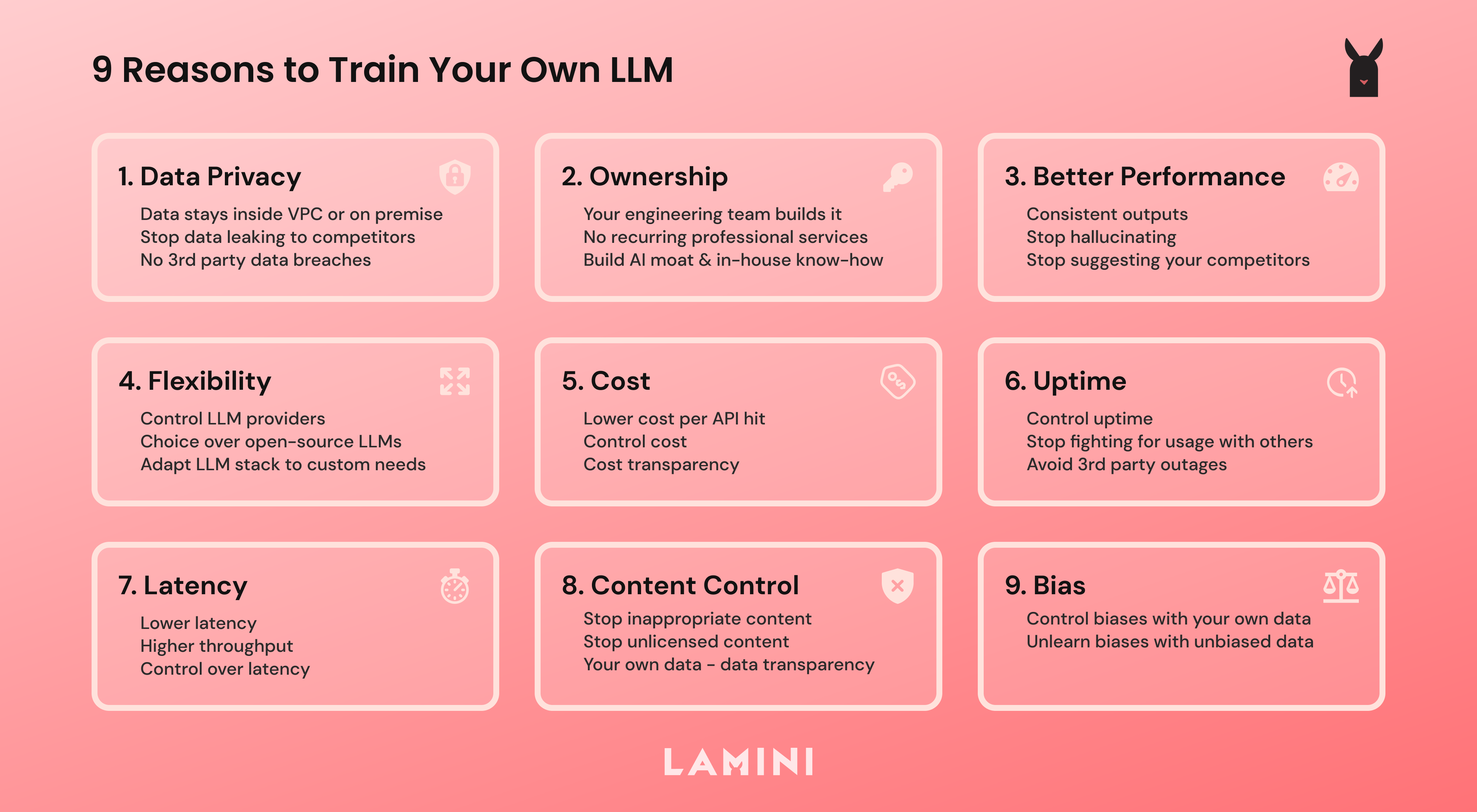Official repo for Lamini's finetuning pipeline, so you can train custom models on your data.
- It's free, on small LLMs
- It's fast, taking 10-15 minutes
- It's like working with an unlimited prompt size, with 1000x+ more space than the largest prompts
- It's learning new information, not just trying to make sense of it given what it already learned (retrieval-augmented generation)
What's here?
- 1400 question and answer dataset (it's about Lamini's internal engineering docs, but you can customize it to your own data)
- The code to run LLM finetuning on this dataset
- Open-source fine-tuned LLMs that answer questions (e.g. about Lamini, or whatever you'd like to customize it to)
See our blog for layperson's terms of what's going on.
Train with ease, by walking through the Colab notebook.
This is an example of a tiny LLM performing basic finetuning. If, instead, you're thinking "I'm ready for the real deal 💪", if you want to build larger LLMs, run this live in production, host this on your own infrastructure (e.g. VPC or on premise), or other enterprise features, please contact us.
- Authenticate
- Run finetuning with Python or Docker
# Instantiate the LLM
from llama import QuestionAnswerModel
model = QuestionAnswerModel()
# Load data into the LLM
model.load_question_answer_from_jsonlines("seed.jsonl")
# Train the LLM
model.train()
# Compare your LLM: before and after training (optional)
results = model.get_eval_results()
# Run your trained LLM
answer = model.get_answer("What kind of exercise is good for me?")
- Modify the default dataset to your own
Here's what you should expect from the LLM before and after finetuning, i.e. on the question-answer data.
You ask the question:
How can I add data to Lamini?
Before finetuning:
A:
I think you can use the following code to generate the
After finetuning:
You can add data to Lamini using the `add_data()` function. This function takes in a string of text and adds it to the model.
As you can see, the base model without finetuning is really off the rails and cuts itself off. Meanwhile, finetuning got the LLM to answer the question correctly and coherently!
First, navigate to your Lamini account page to retrieve your unique API key. 🔑 Remember to keep this key a secret, and don't expose it in any client-side code or share it with others. When you log in, you can also track your training jobs. Finetuning the small default LLM is free.
Next, create a config file, like so:
mkdir ~/.powerml
touch ~/.powerml/configure_llama.yaml # backend system names
Finally, open the file with a text editor and place your key in it:
production:
key: "<YOUR-KEY-HERE>"
The Lamini python package will automatically load your key from this config file for you, so you don't have to worry about it 🙌
If you're running Lamini in a docker container, make sure to copy/mount this file inside the container 🐳
See our API docs for more details.
Clone the repository:
git clone git@github.com:lamini-ai/lamini.git
In the repository, install python dependencies:
pip install -r requirements.txt
Run the program, to start finetuning
python3 training_and_inference.py
All that's happening in there are these easy steps to finetune:
- Instantiate the LLM
model = QuestionAnswerModel()
- Load data into the LLM
model.load_question_answer_from_jsonlines("seed.jsonl")
- Train the LLM
model.train()
- Compare your LLM: before and after training (optional)
results = model.get_eval_results()
- Run your trained LLM
answer = model.get_answer("How can I add data to Lamini?")
Make sure you have docker installed.
Then, run this command:
./run_finetuning.shThis runs the Docker container and the script to finetune.
To use your own data for finetuning, we suggest you creating dataset in the same format as the seed.jsonl file in the data folder.
After that, you can put the new file in the data folder and then change the path in the training_and_inference.py file.
The seed.jsonl follows following format:
{"question": "type your question", "answer": "answer to the question"}
Both the quality and quantity of the questions and answers help the LLM learn. Just like a person would :)
To use different models for finetuning, you can pass in model_name parameter to QuestionAnswerModel(), for example:
model = QuestionAnswerModel(model_name="YOUR_MODEL_NAME")
Currently the free tier version supports limited models:
- hf-internal-testing/tiny-random-gpt2
- EleutherAI/pythia-70m
- EleutherAI/pythia-70m-deduped
- EleutherAI/pythia-70m-v0
- EleutherAI/pythia-70m-deduped-v0
- EleutherAI/neox-ckpt-pythia-70m-deduped-v0
- EleutherAI/neox-ckpt-pythia-70m-v1
- EleutherAI/neox-ckpt-pythia-70m-deduped-v1
- EleutherAI/gpt-neo-125m
- EleutherAI/pythia-160m
- EleutherAI/pythia-160m-deduped
- EleutherAI/pythia-160m-deduped-v0
- EleutherAI/neox-ckpt-pythia-70m
- EleutherAI/neox-ckpt-pythia-160m
- EleutherAI/neox-ckpt-pythia-160m-deduped-v1
- EleutherAI/pythia-410m-v0
- EleutherAI/pythia-410m-deduped
- EleutherAI/pythia-410m-deduped-v0
- EleutherAI/neox-ckpt-pythia-410m
- EleutherAI/neox-ckpt-pythia-410m-deduped-v1
- cerebras/Cerebras-GPT-111M
- cerebras/Cerebras-GPT-256M
To add support for more models, contact Lamini team here.
Lamini is the LLM platform for every developer to build customized, private models: easier, faster, and better-performing than any general purpose LLM.. It is based on the lamini tribe, which includes llamas (LLMs!), alpacas, etc.



